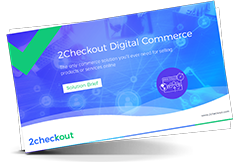So you want to start a business? An eCommerce business you say?
There are so many eCommerce business opportunities! You’ve come to the right place because 1) it’s not very hard to start an eCommerce business from scratch, 2) there are so many ideas for eCommerce businesses, and 3) we will show you how!
There’s a quite simple formula to follow to be successful. It starts with an idea, figuring out how you’ll make money, and then bringing it to life.
Bonus: Check out this comprehensive guide on how to write a perfect eCommerce business plan.
Decide on a product or service and define your niche buyer personas
You may want to sell a physical good like clothing, tools, or home decor; or you may want to sell digital goods like music soundtracks, lessons, or courses. If you are leaning more towards the route of physical goods you could consider creating a subscription-based eCommerce business where you curate a variety of products to be sent at regular intervals.
- What product do you want to offer and how will it be delivered?
- How are other similar companies selling their product?
- Is there room for you to be different?
It’s important to know who you plan on selling to and not falling for subjective beliefs like “Everybody needs my product”. Your audience will set the tone for everything you do and will provide the focus you need to launch a successful business. By targeting a specific audience you’ll be able to identify whether anyone will actually buy your product (which you definitely want to know sooner rather than later!). You may have 2 or 3 key audiences or buyer personas, but it’s fine to have just one. Once you have your audience, research them inside and out, and forwards and backwards, to keep from wasting marketing money. For more guidance on creating your buyer persona(s), check out this blogpost.
Select your business model
There are various ways you could go about selling your product: the historically standard method of purchasing where a user goes to the site, identifies the item they want and then makes a purchase, or the new subscription model where the customer is sent a new product, based on your theme, at predefined intervals. If the subscription model intrigues you, definitely check out our infographic to get better acclimated to the upside of the subscription model. The model you choose may depend on what you are trying to sell. For example, a subscription model wouldn’t work for custom-made items.
Here are some other fulfillment models to be aware of:
- Manufacturing. This is when you want to make your product from scratch.
- Warehousing. Buy products in bulk and resell them for a profit
- Dropshipping. When you order your product from the seller, send it to the customer and never even need to touch the product.
Your model choice will depend on lots of things including your personality, how much flexibility and control you want to have, cost effectiveness orwhat your product is.
Register your eCommerce business
This is one of the most un-fun parts of having a business, but oh so necessary. The good thing is that, once you actually get around to doing it, the process is relatively simple. Start by informing yourself of what the requirements are to conduct business in your country, state/province, and city.
- Look into reporting and tax requirements not only for where you are located, but also for where you will be selling.
- Register your company with the state and get your local business license.
- Register your trademarked name at the national level.
- Enroll for a VAT (value added tax identification number) if you are US-based and will be doing business internationally, and an EIN (employer identification number) for conducting U.S. business. The EIN will also double as your tax ID number. Some of these will have to be renewed on an annual basis.
See? That’s not too much! It’ll be done before you know it.
Set up your website brand
Your brand is the first thing your customers see and experience before they even touch your product. It’s so important because it helps people connect with you. Because it drives connection, everything about your brand needs to revolve around who your target audience is and how you are unique compared to your competitors.
- Choose a name. Your name should make sense, be catchy or easy to remember, and strike a chord with your audience. If people can’t easily repeat or spell your name, that would be a big marketing problem! While choosing the name, it’s wise to see if the URL is available. Sending people to a different URL, that doesn’t match your brand too much, could confuse potential buyers.
- Create a logo. Your logo should communicate who you are and what your brand represents. Use an appropriate color palette. Did you know that different colors represent different emotions? You can play these colors to your strengths to help your brand communicate the right message.
- Find something that makes you unique. Differentiate yourself from your competitors. Is your product eco-friendly when other similar products aren’t? Can you sell it at a cheaper price? Is your customer service far better?
- Decide on your pricing. What kind of profit margin do you want to see? What is your target audience willing to pay? What does your competition charge?
- Come up with your marketing strategy. A solid marketing strategy will help your customers find you. Facebook, Instagram, and Pinterest are visual platforms where people love to shop. Consistent interaction on these platforms with similar messaging, voice, and branding will help build your relationship with your customers.
Build your online store
Once you’ve set up your company’s brand identity, your next step is building the store and starting to sell! To get your website up and running, you’ll need to purchase your domain name. It’s probably smart to purchase this early on. The cost of the domain will depend on how desirable of a name it is — it could be very inexpensive!
After you’ve acquired the domain name, it’s time to build your actual website. You can use an out-of-the-box eCommerce platform like Shopify, Wix, or Squarespace, that comes with design templates that you can select, or have your site custom designed and then connected with a compatible shopping cart.
When choosing your site’s platform, pay close attention to these features, to ensure your customers have an optimal experience:
- Load time. Your site and pages need to load quickly. Speed matters — a lot. It matters because it affects your SEO score and it matters because people have such low tolerance for slow processes. 57% of people say they leave a site if it takes longer than 3 seconds to load. That may sound harsh, but it’s true!
- SEO. People should be able to find you easily. Make sure you are using keywords in your copy that people use when searching for a product like yours.
Bonus: Watch this webinar to learn how to maximize your SEO efforts for eCommerce!
- Filters. Customers want to filter and compare your products. If they can’t easily find what they are looking for, they will leave, and if they can find what they are looking for, your conversion rates could be 20% higher!
- Searchability. A product search is a crucial feature! 35% of eCommerce site visitors say they always use the search feature.
- Preferred payment method. If someone likes to get points on their American Express card it’ll leave a sour taste in their mouth if they have to use their Visa, and they certainly won’t want to create a PayPal account if they don’t already have one. Make sure they can pay using the payment method they prefer and opt for a payment supplier which features both international and local payment means.
- Relevant shopping experience. The shopping experience should be culturally relevant to your customers. The slightest bit of uncertainty can make you lose a potential sale. People performing transactions abroad might not even be able to tell you what made them go with another site, but it turns out it was because you didn’t connect with them well over their language and payment currency.
Market the heck out of your eCommerce business
You may have the best product in the world, but if no one knows about it that won’t do you any good!
There are so many different marketing strategies that you can use so you need to choose wisely. You likely won’t have enough time or financial resources to do them all well. No matter what content you end up choosing, apply these tips to get the most out of your efforts.
- Use the right keywords. Make sure you know what keywords people use when they are looking for products like yours. Make sure to use those keywords naturally in your URLs, ads, and any other type of content that is searchable online. Ultimately, though, planning is your best friend.
- Be in the right places. Know which social media platforms and forums your customers are on and be there. Be present with a regularity and language that your customers can come to trust.
- Try affiliate marketing. If there are retailers that are complementary to you, those would be great sites for your brand to affiliate with.
- Get as many email addresses as you can. Gaining email addresses will be you best friend. To get people’s email addresses, try promoting an opt-in freebie or a giveaway. Once you have people’s email addresses you can send them greatly coveted coupons and other relevant content.
- Use influencers. Try to identify some relevant influencers who can try out your product. If they like it, they will use their experience as good content to share with their readership.
Here are some other ideas of free ways to drive people to your site.
Conclusion
The formula for starting an eCommerce business is rather simple, and it can take you less than a month! It may not be perfect in the beginning — in fact, it probably won’t be — but you have to start somewhere. Follow these keys and you’ll be off in the right direction. Good luck with your eCommerce endeavors!
Want to learn how 2Checkout can help you gain a competitive advantage and tackle the complexities of modern commerce? Check out our Digital Commerce Solution Brief!






